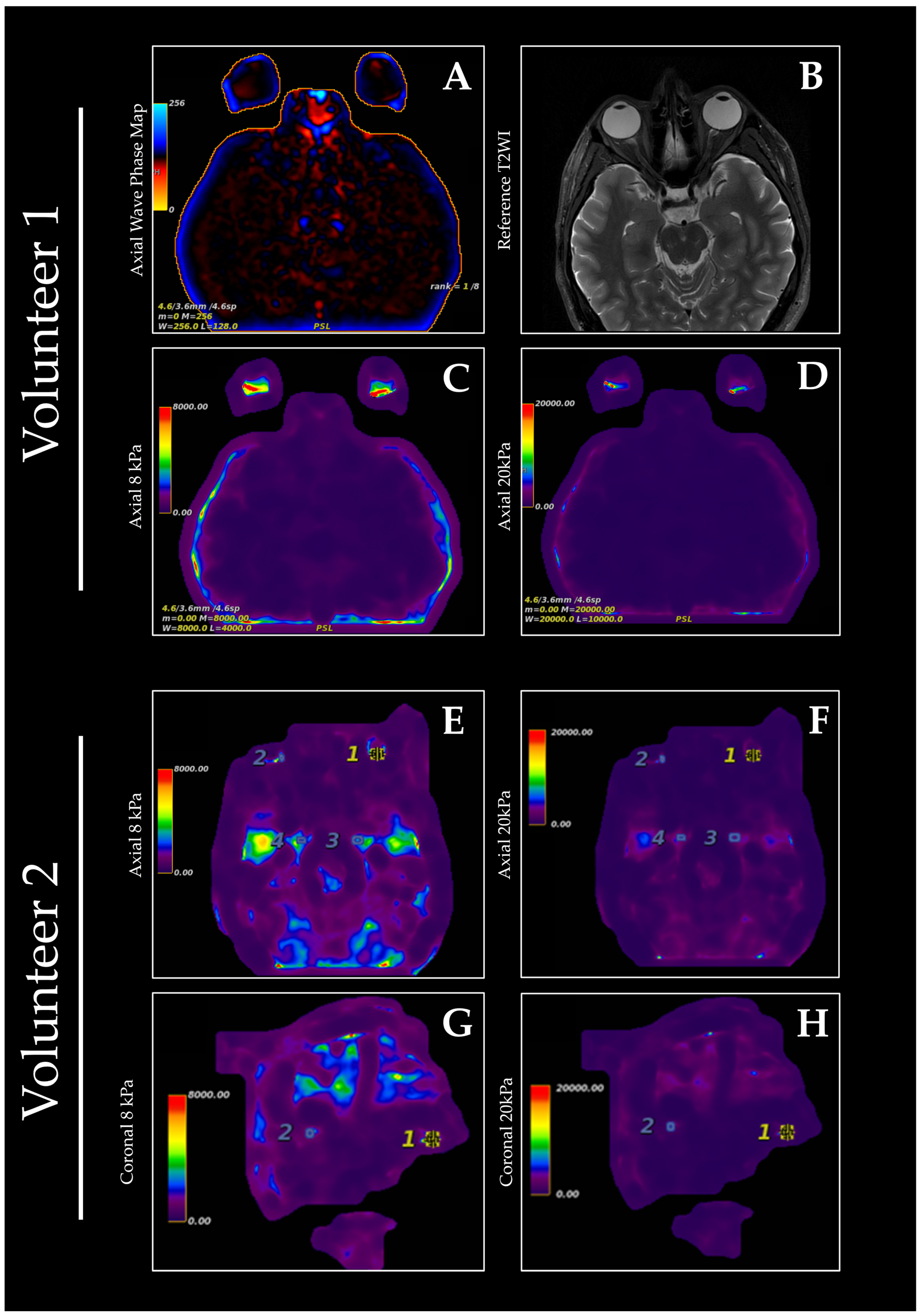Shear Wave MR Elastography of the Orbit: Preliminary Findings
Abstract

Author Contributions
Funding
Institutional Review Board Statement
Informed Consent Statement
Data Availability Statement
Conflicts of Interest
References
- Muthupillai, R.; Lomas, D.J.; Rossman, P.J.; Greenleaf, J.F.; Manduca, A.; Ehman, R.L. Magnetic resonance elastography by direct visualization of propagating acoustic strain waves. Science 1995, 269, 1854–1857. [Google Scholar] [CrossRef] [PubMed]
- Kruse, S.A.; Smith, J.A.; Lawrence, A.J.; Dresner, M.A.; Manduca, A.; Greenleaf, J.F.; Ehman, R.L. Tissue characterization using magnetic resonance elastography: Preliminary results. Phys. Med. Biol. 2000, 45, 1579–1590. [Google Scholar] [CrossRef] [PubMed]
- Tse, Z.T.; Janssen, H.; Hamed, A.; Ristic, M.; Young, I.; Lamperth, M. Magnetic resonance elastography hardware design: A survey. Proc. Inst. Mech. Eng. H 2009, 223, 497–514. [Google Scholar] [CrossRef] [PubMed]
- Yeung, D.K.; Bhatia, K.S.; Lee, Y.Y.; King, A.D.; Garteiser, P.; Sinkus, R.; Ahuja, A.T. MRE of the head and neck: Driver design and initial results. Magn. Reson. Imaging 2013, 31, 624–629. [Google Scholar] [CrossRef] [PubMed]
- Bahn, M.M.; Brennan, M.D.; Bahn, R.S.; Dean, D.S.; Kugel, J.L.; Ehman, R.L. Development and application of magnetic resonance elastography of the normal and pathological thyroid gland in vivo. J. Magn. Reson. Imaging 2009, 30, 1151–1154. [Google Scholar] [CrossRef] [PubMed]
- Cheng, S.; Gandevia, S.C.; Green, M.; Sinkus, R.; Bilston, L.E. Viscoelastic properties of the tongue and soft palate using MRE. J. Biomech. 2011, 44, 450–454. [Google Scholar] [CrossRef] [PubMed]
- Elsholtz, F.H.J.; Reiter, R.; Marticorena Garcia, S.R.; Braun, J.; Sack, I.; Hamm, B.; Schaafs, L.-A. Multifrequency magnetic resonance elastography-based tomoelastography of the parotid glands-feasibility and reference values. Dentomaxillofacial Radiol. 2022, 51, 20210337. [Google Scholar] [CrossRef] [PubMed] [PubMed Central]
- Green, M.A.; Bilston, L.E.; Sinkus, R. In vivo brain viscoelastic properties measured by magnetic resonance elastography. NMR Biomed. 2008, 21, 755–764. [Google Scholar] [CrossRef] [PubMed]
- Streitberger, K.J.; Sack, I.; Krefting, D.; Pfüller, C.; Braun, J.; Paul, F.; Wuerfel, J. Brain viscoelasticity alteration in chronic-progressive multiple sclerosis. PLoS ONE 2012, 7, e29888. [Google Scholar] [CrossRef] [PubMed] [PubMed Central]
- Lipp, A.; Trbojevic, R.; Paul, F.; Fehlner, A.; Hirsch, S.; Scheel, M.; Noack, C.; Braun, J.; Sack, I. Cerebral magnetic resonance elastography in supranuclear palsy and idiopathic Parkinson’s disease. Neuroimage Clin. 2013, 3, 381–387. [Google Scholar] [CrossRef] [PubMed] [PubMed Central]
- Mathur, A.; Jain, N.; Kesavadas, C.; Thomas, B.; Kapilamoorthy, T.R. Imaging of skull base pathologies: Role of advanced magnetic resonance imaging techniques. Neuroradiol. J. 2015, 28, 426–437. [Google Scholar] [CrossRef] [PubMed] [PubMed Central]
- Litwiller, D.V.; Lee, S.J.; Kolipaka, A.; Mariappan, Y.K.; Glaser, K.J.; Pulido, J.S.; Ehman, R.L. MR elastography of the ex vivo bovine globe. J. Magn. Reson. Imaging 2010, 32, 44–51. [Google Scholar] [CrossRef] [PubMed] [PubMed Central]
- Friedlander, M. Fibrosis and diseases of the eye. J. Clin. Investig. 2007, 117, 576–586. [Google Scholar] [CrossRef] [PubMed] [PubMed Central]
- Frueh, B.R.; Musch, D.C.; Grill, R.; Garber, F.W.; Hamby, S. Orbital compliance in Graves’ eye disease. Ophthalmology 1985, 92, 657–665. [Google Scholar] [CrossRef] [PubMed]
- Abràmoff, M.D.; Viergever, M.A. Computation and visualization of three-dimensional soft tissue motion in the orbit. IEEE Trans. Med. Imaging 2002, 21, 296–304. [Google Scholar] [CrossRef] [PubMed]
Disclaimer/Publisher’s Note: The statements, opinions and data contained in all publications are solely those of the individual author(s) and contributor(s) and not of MDPI and/or the editor(s). MDPI and/or the editor(s) disclaim responsibility for any injury to people or property resulting from any ideas, methods, instructions or products referred to in the content. |
© 2025 by the authors. Licensee MDPI, Basel, Switzerland. This article is an open access article distributed under the terms and conditions of the Creative Commons Attribution (CC BY) license (https://creativecommons.org/licenses/by/4.0/).
Share and Cite
Olsen, A.L.; Ginat, D.T. Shear Wave MR Elastography of the Orbit: Preliminary Findings. Diagnostics 2025, 15, 2342. https://doi.org/10.3390/diagnostics15182342
Olsen AL, Ginat DT. Shear Wave MR Elastography of the Orbit: Preliminary Findings. Diagnostics. 2025; 15(18):2342. https://doi.org/10.3390/diagnostics15182342
Chicago/Turabian StyleOlsen, Ayden L., and Daniel T. Ginat. 2025. "Shear Wave MR Elastography of the Orbit: Preliminary Findings" Diagnostics 15, no. 18: 2342. https://doi.org/10.3390/diagnostics15182342
APA StyleOlsen, A. L., & Ginat, D. T. (2025). Shear Wave MR Elastography of the Orbit: Preliminary Findings. Diagnostics, 15(18), 2342. https://doi.org/10.3390/diagnostics15182342






